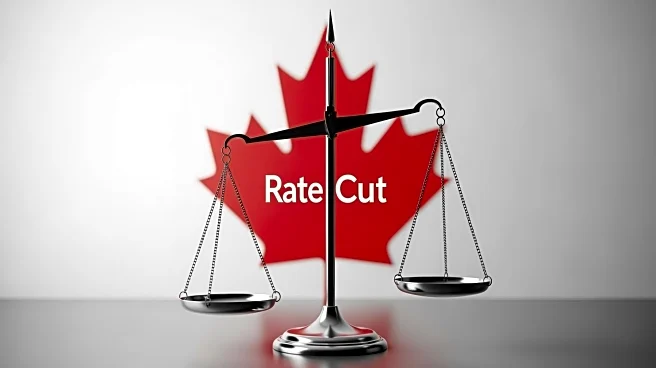What's Happening?
The Canadian dollar remained stable near a six-month low against the U.S. dollar, influenced by falling oil prices and the Bank of Canada's quarterly surveys. These surveys suggest a potential interest
rate cut, as Canadian businesses express cautious optimism amid U.S. tariffs. The loonie traded at 1.4025 per U.S. dollar, reflecting slight improvements in business conditions compared to earlier in the year. However, firms are hesitant to increase investments or hiring due to the dampening effects of U.S. economic policies. The currency's recent performance highlights ongoing economic challenges and the impact of international trade dynamics.
Why It's Important?
The stability of the Canadian dollar and potential interest rate cuts have significant implications for Canada's economy. A rate cut could stimulate economic activity by making borrowing cheaper, encouraging investment and spending. However, the cautious sentiment among Canadian businesses indicates concerns about the broader economic environment, particularly in relation to U.S. tariffs. These factors could affect Canada's trade balance and economic growth. The Bank of Canada's decisions will be closely watched by investors and policymakers, as they navigate the complexities of international trade and domestic economic conditions.
What's Next?
The Bank of Canada is expected to make a decision on interest rates soon, with market expectations leaning towards a cut. This decision will be influenced by ongoing assessments of business and consumer sentiment, as well as external economic pressures. The outcome could impact the Canadian dollar's value and influence investment strategies. Businesses may continue to exercise caution, focusing on adapting to changing trade policies and economic conditions. The central bank's actions will play a crucial role in shaping Canada's economic trajectory, as it seeks to balance growth and stability amid global uncertainties.
Beyond the Headlines
The potential rate cut by the Bank of Canada reflects broader economic challenges, including the impact of U.S. tariffs and global trade tensions. These factors contribute to a complex economic landscape, where businesses must navigate uncertainties and adapt to shifting policies. The stability of the Canadian dollar is crucial for maintaining investor confidence and supporting economic growth. The central bank's approach to monetary policy will be pivotal in addressing these challenges, ensuring that Canada remains competitive in the global market while safeguarding domestic economic interests.












